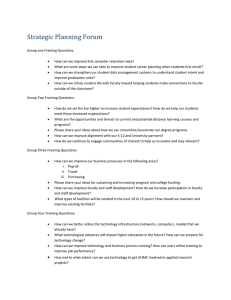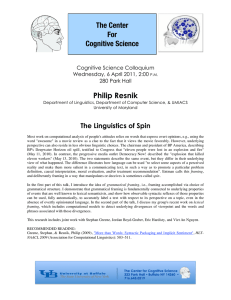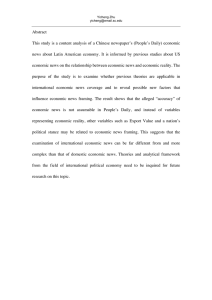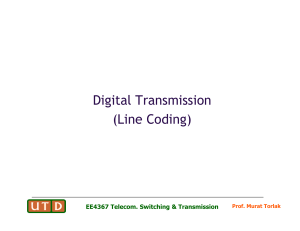Time Division Multiplexing
advertisement
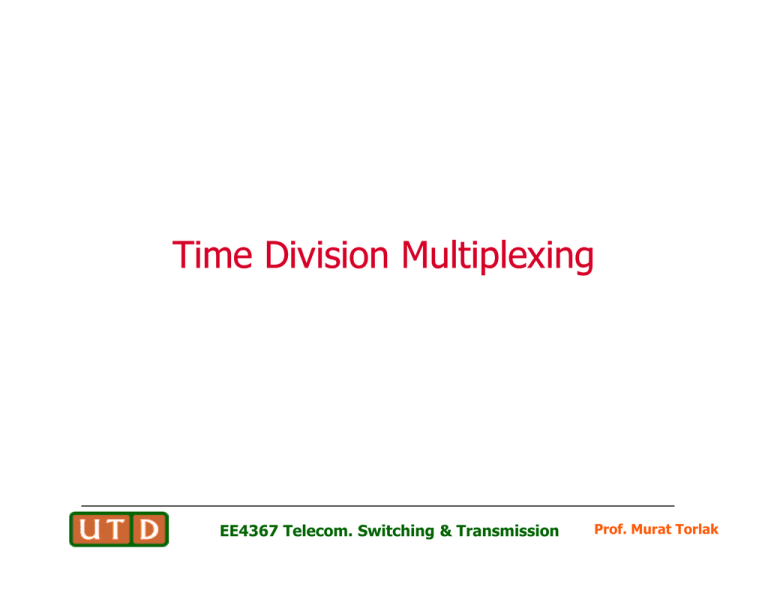
Time Division Multiplexing EE4367 Telecom. Switching & Transmission Prof. Murat Torlak Basic Modes of Operation TDM Modes Synchronous Mode: repeatedly assigning the transmission channel. Ex: STDM (circuit switching) Asynchronous Mode: as needed, Ex: ATDM, ATM, Stat-Mux (packet switching) TDM structures Bit interleaving: single bit Word Interleaving: larger number of bits (word-length) EE4367 Telecom. Switching & Transmission Prof. Murat Torlak E1/T1 Difference The E1 system is dominant in Europe and some non-Europe countries. The T1 system is dominant in USA, Canada and Japan. E1 and T1 use the same sampling frequency (8 kHz), PCM frame length (125 ms), bits per code (8 bits) and timeslot bit rate (64 kbps). They differ in these aspects: E1 adopts A law coding/decoding of 13-segment but T1 adopts m law coding/decoding of 15-segment. Each PCM primary frame of E1 contains 32 timeslots but T1’s contains 24 timeslots. Each PCM primary frame of E1 contains 256 bits but T1’s contains 193 bits. Therefore, E1 provides 2.048 Mbps bandwidth but T1 provides 1.544 Mbps bandwidth. EE4367 Telecom. Switching & Transmission Prof. Murat Torlak Framing To identify individual time slots Overhead bits are required to establish frame synchronization Basic means of establishing frame synchronization Added-bit Added-channel Unique line signal Statistical Loss of framing implies a loss of data on all channels Reframing time and frequency of accourance Source of out of frame conditions Sample clock may lose synchronization with the line clock and produce a slip in the counter sequence Channel errors. To prevent channel errors high redundancy in framing patter is needed. EE4367 Telecom. Switching & Transmission Prof. Murat Torlak Added--Digit Framing Added Periodically interting a framing bit with a identifiable data sequence. Added once for every frame and alternates in value. It is used D1 channel banks. Frame length is 193 bit in D1 channel banks. Framing is established in a receiving D1 channel bank by monitoring first one bit position within a 193-bit frame and then another, until the alternating pattern is located. With this framing strategy, the expected framing time from a random starting point with random date is given as Frame Time=N2+N/2 bit times where N is the number of bits in a frame time N=193 the framing time is 37,346 bits or 24.188msec EE4367 Telecom. Switching & Transmission Prof. Murat Torlak Added--Digit Framing Added EE4367 Telecom. Switching & Transmission Prof. Murat Torlak Added--Channel Framing Added Frame digits are added in a group such that an extra channel is established The E1 standard (ITU) uses 32 channels per frame. One timeslot is reserved for framing purposes, and alternately transmits a fixed pattern. This allows the receiver to lock onto the start of each frame and match up each channel in turn. FAS: Frame alignment signal Another channel is used for signaling. L is the length of the frame code E1: N=512 and L=7 0.5 msec, much faster than DS1 added- digit frame times EE4367 Telecom. Switching & Transmission Prof. Murat Torlak
